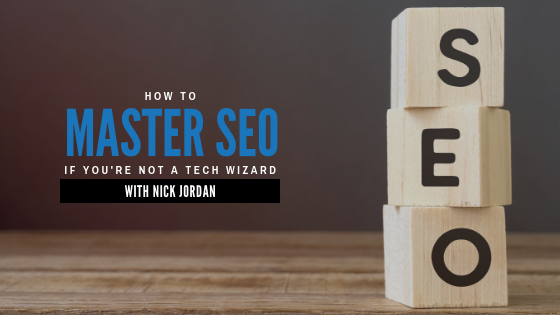Nick Jordan is a marketing strategist whose workload includes driving revenue growth via organic search for CEOs, executives, and entrepreneurs.
He has taken all of this SEO knowledge and channeled it into digital marketing. In less than a year, he boosted the organic search traffic of his company, Logic Inbound, from 500 visitors per month to over 100,000.
Because his SEO know-how is so valuable, Nick has been known to give keynote speeches at the Microsoft Hosting Summit.
On the podcast, Nick discusses the demystification of SEO and how you can rank high without being a tech wizard.
What are the Top Ranking Factors in the Current Marketing Landscape?
While some might say that there are hundreds of ranking factors, Nick and his team only focus on about five and are able to drive 90% of the outcomes they achieve.
So, it’s actually simpler than people make out.
Google’s goal is to show the highest quality, most relevant result for any given search query. So, all you have to do is to make sure your posts are of the highest quality and most relevant. If you do this, you can easily be ranked above more powerful domains.
Due to market pressure, engines like Google are highly incentivized to provide the best search results possible, because if they don’t, users will quickly catch on and go elsewhere.
In recent years, Google has begun implementing small snippets of featured information in their search results, which comes from them. This has taken up a bit of the real estate and has some people wondering if SEO’s best days are behind it.
What are the First Steps to Take When Getting Your Site Ranked?
Assuming you already have a website and a business that can monetize organic search traffic, your first step should be to figure out what you want to rank for.
Many small businesses might rely too heavily on pushing out content to their thousand followers or their email list, but the amount of people who are going to interact with that content is very low.
Instead, Nick believes in working backward.
He finds out what people are searching for and he provides an answer. It’s a far more analytical approach than the feelings-based approach that might come more naturally.
Once you have this piece of content that’s an answer, it will become a valuable asset and continue to provide.
How Do You Decide What to Rank For?
Nick’s first consideration is, “who typically hires our company?” Then, he starts to think what they might be searching for. Eventually, he started targeting platforms that business owners might be using, such as Shopify, LinkedIn and Facebook, then created content that aligns with those kinds of searches.
Starting with a seed keyword is a great place to start. Take that word and put it into a search engine. Find out how people are using it in informational questions.
Use this to form your content and you’ll have a good chance of ranking high.
What are the Tricks to Getting Your Content Highly Ranked?
One of the primary ways that Google measures the quality of content is by way of user engagement metrics. These metrics include time on site, pages visited and other kinds of general engagement, all of which can be gained by social media.
This can get you on the front page, but organic search results will keep you there.
Your URL, meta-title, meta-description, H1s, and H2s are also major factors in getting your content to rank high.
Structured data, such as lists, tables and bullet points are far more effective in Google’s algorithm, as well. Google believes that content such as this is more appealing to users, which is why it’s given precedence.
Using these tools and others, Nick recounts a time he was able to write a blog on Shopify and have it rank higher than Shopify’s own links. Part of this was the poor description of Shopify’s link and that they had no structured data.
Nick’s page, on the other hand, had pictures, H2s, and bullet points.
How Did Nick Outrank Instagram?
To outrank Instagram, Nick focused on the keywords, “contact Instagram.” In addition to these, he scoped out every possible variation that people were likely to type in. Having multiple keywords is important.
Just as with the Shopify blog, Instagram’s links weren’t very well thought out, as they had bad meta-titles and meta-descriptions.
By using superior SEO techniques, such as pictures, structured content and thought-out meta-descriptions, Nick was once again able to topple the bigger opponent.
Another trick that Nick has is to create “columns,” which are essentially multiple pieces of content centered around one subject. By doing this, you’re able to cover all the bases and truly excel in that particular subject.
How Many Articles Do You Need to Have Around a Subject?
It depends on what you’re writing about. If you’re writing about the U.S. Open, then you’re going to need at least 20 articles, especially if you’re a smaller business with a modest online presence. You need to be constantly writing about a subject if you want to make a digital impression.
However, you want to be smart about which articles you are going to write. There’s no need to write an article for how to cure tennis elbow and then another for treatments for tennis elbow. They should be the same article.
Bigger companies can get away with fitting all of their SEO practices into a single article, but smaller companies need to get a wide berth.
Where Can You Learn More About Nick Jordan?
If Nick’s ideas about mastering SEO sound interesting and you’d like to learn more, you have a variety of options.
On the social media front, Nick can be found on LinkedIn, Instagram and Facebook.
For those who like Nick’s ideas but aren’t confident in their ability to carry them out, his company offers their very own developing tools for SEO, which you can learn more about at logicinbound.com.
About Nick Jordan
Nick Jordan is a marketing strategist who helps CEOs, entrepreneurs and executives identify opportunities across the funnel to drive revenue growth via organic search.
He has helped companies generate incredible revenue by creating partnerships with the largest telecommunication and hosting companies in North America and their peers across Europe and Asia.
Nick has funneled all of his knowledge and experience into the digital marketing sphere and has played a pivotal role in growing Logic Inbound’s organic search traffic from just 500 to more than 100,000 visitors per month in a span of a year, out-ranking Instagram and Shopify for branded terms in the process.
Nick has been featured on Inc.com, delivered keynote presentations at the Microsoft Hosting Summit and spoken about marketing at Stacking Growth and Seattle Search Network.














